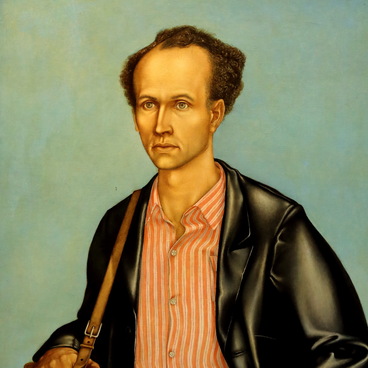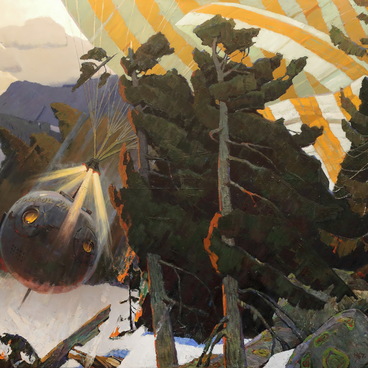The Ural artist Leonid Kolmakov dedicated several decades of his career to the industrial Nizhny Tagil. The city became a character in his works and was depicted numerous times, including in such a genre as the industrial landscape. Such landscapes regularly participated in municipal, regional, all-Russian, and all-Union exhibitions. This tendency corresponded with the art development during that period with Soviet painting quickly adapting to the positive changes in the country’s industry.
So, in 1967, Nizhny Tagil became witness to the construction of the sixth blast furnace of the Nizhny Tagil Iron and Steel Works (NTMK), one of the largest facilities in the country. Leonid Kolmakov responded to the event with his industrial landscape titled “Blast Furnace 6 for the NTMK as Ordered”. The painting was finished in 1969, coinciding with the end of the construction of the furnace.
Kolmakov depicted the final stage of the construction of the furnace before it was put in operation. The enormous blast furnace is in the center of the composition, while the long crane booms and small figures are partly hidden by white puffs of steam. Leonid Kolmakov chose a beautiful silver-gray color scheme and enriched it with accent colors of restrained red-brown and yellow.
Nizhny Tagil is the second-largest city in Sverdlovsk Oblast. The biggest industrial center of the Urals was founded in 1722 by the Tula industrialists Nikita and Akinfiy Demidov. The city became the capital of their major mining and metallurgical center that they called “the iron kingdom”.
The natural wealth of the Nizhny Tagil region rich in iron and copper, gold and platinum became legendary. The iron produced by the Nizhny Tagil factories with the stamp “Stary Sobol” (Old Sable) was in great demand in Europe, especially in France and England. It was valued even more than the Swedish iron, and it repeatedly received awards at international exhibitions in the 19th century. By the 20th century, Nizhny Tagil had firmly established itself as a prominent growing industrial center.
So, in 1967, Nizhny Tagil became witness to the construction of the sixth blast furnace of the Nizhny Tagil Iron and Steel Works (NTMK), one of the largest facilities in the country. Leonid Kolmakov responded to the event with his industrial landscape titled “Blast Furnace 6 for the NTMK as Ordered”. The painting was finished in 1969, coinciding with the end of the construction of the furnace.
Kolmakov depicted the final stage of the construction of the furnace before it was put in operation. The enormous blast furnace is in the center of the composition, while the long crane booms and small figures are partly hidden by white puffs of steam. Leonid Kolmakov chose a beautiful silver-gray color scheme and enriched it with accent colors of restrained red-brown and yellow.
Nizhny Tagil is the second-largest city in Sverdlovsk Oblast. The biggest industrial center of the Urals was founded in 1722 by the Tula industrialists Nikita and Akinfiy Demidov. The city became the capital of their major mining and metallurgical center that they called “the iron kingdom”.
The natural wealth of the Nizhny Tagil region rich in iron and copper, gold and platinum became legendary. The iron produced by the Nizhny Tagil factories with the stamp “Stary Sobol” (Old Sable) was in great demand in Europe, especially in France and England. It was valued even more than the Swedish iron, and it repeatedly received awards at international exhibitions in the 19th century. By the 20th century, Nizhny Tagil had firmly established itself as a prominent growing industrial center.

